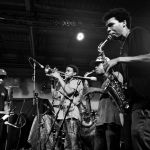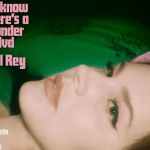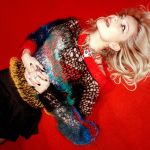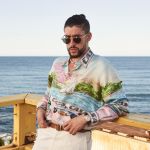
Il cubismo musicale degli Standing On The Corner
Dopo aver raggiunto il grande pubblico grazie all'ultimo disco di Earl Sweatshirt, il duo/collettivo newyorkese è pronto a lasciare il segno
January 19th, 2019
I discovered that the best way to listen to Standing on the Corner is to sit on a bus in the middle of the city traffic, on a seat that makes you turn your back on the road. For some reason that is the natural habitat of their music.
Why is that? Maybe it does have to do with the sense of estrangement that makes going forward being turned backwards, or the fact that these two actions (moving forward and sitting down) are extremely natural when taken singularly, but completely unnatural putted together.
Yet life has accustomed us to the fact that an undeniable logic prevails in the seat on a mechanical means that transports us to where we must go, while we observe in "reverse" from the window the daily madness of the metropolis.
The Standing on the Corner project stems from the encounter between two 20-year-olds who live and take public transportation in New York; the lyricist and composer Gio Escobar and the producer Jasper Marsalis. Around the two gravitate collaborators or simple friends who work in the most disparate fields, other musicians, graphic artists, photographers, artists and so on. Standing on the Corner has on the record the 2016 debut of the same name and above all the impressive "Red Burns"; in the last year they also made themselves known for having opened several concerts of King Krule and having participated in the last, fantastic album by Earl Sweatshirt, "Some Rap Songs".
Their first work is a collection of about thirty minutes of strange compositions halfway between indie, jazz influences and electronics in a hip-hop key - with the use of the decidedly pre-eminent and original sampling technique. With "Red Burns" the formula has not changed much, but has refined becoming audacious in an almost provocative way: only two tracks of about thirty minutes each, which result in more than an hour of constant and uninterrupted music flow. The element that is most taken to the extreme is that of sampling and their amalgamation with the "organic" parts of the pieces or with themselves. If on the first record we could still perceive, although often very latent, a reassuring song form, here we are completely at risk, we have no grip, we float in an indefinite and enveloping sound mass.
Listening to them the first time could create a feeling almost claustrophobic, as if we were in a completely dark room that we do not know, so that we do not know where to put hands and feet. At a certain point, however, it becomes clear that it is useless to go crazy in looking for a center or any type of familiar form, but rather that we must abandon ourselves completely to the flow, as the hippies who were so stoned in the sixties sad. It is precisely at that moment that one comes to the head of the matter and one begins to enjoy everything, and the light comes on like magic.
We are able to abandon ourselves totally to their art since in "Red Burns" the two are very good at carrying out a precise concept that is not at all a precise concept. The record begins with a narrative voice that after having clarified that he is speaking from America, New York specifically, states that "the ability to breathe is what this record is about", since "here many find difficulty in breathing ": a clear reference to the tragic death of Eric Garner, an African-American boy killed by suffocation, in 2014, by a policeman who crushed him on the ground and whose desperate request for air" I can not breathe "became the slogan of the Black Lives Matters movement and is sampled in the first seconds of the Standing on the Corner album. Also in the lyrics we find therefore this narrative ability similar to the same raw and raw musical material, the cubist ability to describe a landscape (in this case social and political) using all the facets and points of view possible, bringing everything together in the same "image" "; to convey themes in a very intelligent way, as explained by themselves in an interview with Pitchfork:
"The sampling for me is about contextualizing the songs without being trivial: how can we say in our music that black lives count without roaring like a slogan 'Black Lives Matter!'? We channel and activate these things that make our vision progress, but also maintain the dignity of the thing in question. It is not about making it accessible, but simply letting people know that this is something that is part of the world. It's about freedom to be expressive in ways you can not do when you find yourself in constraints imposed on you or anyone else. "

Looking closely, I have their same age, and perfectly match me in their music: at the same time terribly exciting and distressing, that is how I perceive my life and that of the people around me every day, as if it were a constant exercise by trapeze artists without a network under - precisely the sensation evoked by their productions.
In this, the extreme and innovative use of the sampling technique, is configured as the most effective way from me until now heard in interpreting and at the same time transcend our contemporaneity, its being, very trivially, so fragmentary and confusing but also dangerously fascinating, imbued with the unbridled accelerationism in which we live and of which we are simultaneously spectators.
What they can do is reunite in some way "the electronic bedroom", or that world of creative solitude that every twenty years of today knows very well (linked to the world of lo-fi), an urban landscape that by those who live in metropolis are absolutely clear from the first listening on the part, which has its roots in hip-hop and black music more generally, but also in art-rock and in an imaginary (through videos, the artwork or the simple photos that they turn of themselves) that seems the punk and low-budget evolution of that of the first Odd Future. Something that they have confirmed themselves, always in the same interview with Pitchfork: "We are not just in our fucking rooms to do beats: we are very influenced by the outside world and by the 'conversation' we have with it."

We are not talking about music that can only be appreciated by the educated twenty years old.
Standing on the Corner tracks are imbued with unbridled quotationism that allows almost everyone to take an interest in their art. It is not futuristic electronic and HD that excludes the past in a categorical way, nor a revival of sounds already heard presented in such a way as to seem like a novelty. We are faced with a different, exciting and new formula, which could really be the first step towards something extremely dynamic and exciting - to some extent still raw and embryonic but with incredible potential.
Citing comparisons very uncomfortable and deliberately provocative, the first time I listened to these two of my peers, I have caused an effect very similar to the first time I heard the Art Enseble of Chicago, or the Sun Ra Arkestra. An impression that if I had thought at first risky, I was actually confirmed a few days later by an episode of the podcast Earl Sweatshirt in which together with Gio of the SOTC paid tribute to Sun Ra on his birthday.
redbullradio
They have already achieved their cult status. We will see if in the near future they will be able to leave an even deeper mark, perhaps the bearer of an artistic-musical legacy even if only vaguely similar to that of the two sacred monsters I mentioned.





















































